How Big Is the Global Carbon Offsetting Market (Big Enough?)
Impactful Ninja is reader-supported. When you buy through links on our site, we may earn an affiliate commission.
Learn more
Learn more
.
Hey fellow impactful ninja ? You may have noticed that Impactful Ninja is all about providing helpful information to make a positive impact on the world and society. And that we love to link back to where we found all the information for each of our posts. Most of these links are informational-based for you to check out their primary sources with one click. But some of these links are so-called "affiliate links" to products that we recommend. First and foremost, because we believe that they add value to you. For example, when we wrote a post about the environmental impact of long showers, we came across an EPA recommendation to use WaterSense showerheads. So we linked to where you can find them. Or, for many of our posts, we also link to our favorite books on that topic so that you can get a much more holistic overview than one single blog post could provide. And when there is an affiliate program for these products, we sign up for it. For example, as Amazon Associates, we earn from qualifying purchases. First, and most importantly, we still only recommend products that we believe add value for you. When you buy something through one of our affiliate links, we may earn a small commission - but at no additional costs to you. And when you buy something through a link that is not an affiliate link, we won’t receive any commission but we’ll still be happy to have helped you. When we find products that we believe add value to you and the seller has an affiliate program, we sign up for it. When you buy something through one of our affiliate links, we may earn a small commission (at no extra costs to you). And at this point in time, all money is reinvested in sharing the most helpful content with you. This includes all operating costs for running this site and the content creation itself. You may have noticed by the way Impactful Ninja is operated that money is not the driving factor behind it. It is a passion project of mine and I love to share helpful information with you to make a positive impact on the world and society. However, it's a project in that I invest a lot of time and also quite some money. Eventually, my dream is to one day turn this passion project into my full-time job and provide even more helpful information. But that's still a long time to go. Stay impactful,Affiliate Disclosure
Why do we add these product links?
What do these affiliate links mean for you?
What do these affiliate links mean for us?
What does this mean for me personally?
![]()
The global carbon offset market is a billion (B) dollar industry with a mission to reduce carbon emissions in order to mitigate climate change, creating a sustainable planet for future generations. But just how big is the market? And is it big enough to account for all of our emissions?
The total carbon offset market is valued at over $262B. It consists of the mandatory and voluntary markets, which are valued at roughly $261B and $1B, respectively, and both are projected to grow strongly. Together, they cover ~12 GtCO2e, representing more than 20% of global GHG emissions.
Keep reading to learn how big the global carbon offset market is, if it’s big enough, what some of the reasons are that make it controversial, as well as what better alternatives to carbon offsets are.
How Is the Global Carbon Offsetting Market Defined
Carbon offsets are measured in tons of carbon dioxide (CO2) equivalents and are bought and sold through international brokers, online retailers, and trading platforms on what is known as the global carbon offset market. The total global carbon offsetting market encompasses two types of markets, the first of which is the mandatory market.
“Mandatory carbon offset market: created and regulated by mandatory national, regional, or international carbon reduction regimes”
Carbon Offset Guide
Companies mandated to reduce carbon emissions from daily operations do so via mandatory carbon offsets.
The second type of global carbon offset market is the voluntary carbon offset market (VCM).
“Voluntary carbon offset market: function[s] outside of compliance markets and enable[s] companies and individuals to purchase carbon offsets on a voluntary basis with no intended use for compliance purposes”
Carbon Offset Guide
The VCM is the more common and more utilized carbon offset market, and it is where everyday consumers can purchase carbon offsets to offset their carbon emissions.
“Carbon Emissions: carbon dioxide that planes, cars, factories, etc. produce, thought to be harmful to the environment”
Cambridge Dictionary
When you hear the words “carbon offset”, think about the term “compensation”. Essentially, carbon offsets are reductions in carbon emissions that are used to compensate for carbon emissions occurring elsewhere. Because carbon emissions are found everywhere in our atmosphere, cutting them at any location on earth provides emission reduction benefits.
Here Is How Big the Global Carbon Offsetting Market Is
Carbon offsetting has gone through three distinct development phases in its development over the last thirty years, with the most recent and important being the mainstreaming phase. This phase has seen market growth, corporate awareness, and validation of standards by compliance systems.
- The term “offset” has been used since the 1970s as part of the Clean Air Act, and “carbon offsets” became popularized in the first decade of the 21st century as concerns grew about human-induced climate change via the release of greenhouse gases.
- Carbon offsetting began in 1989 with an agriforest in Guatemala., when Applied Energy Services, an American electric power company, decided to finance an agriforest to offset the emissions of their new, coal-fired power plant in Connecticut.
- Key events include the 1995 Kyoto Protocol, the 2005 EU Emissions Trading Scheme (the first carbon offset program to exist), and the 2015 Paris Agreement.
Related: Are you interested in getting the big picture of carbon offsetting’s history? Check it out in this article here: The History of Carbon Offsetting: The Big Picture
The total global carbon offset market is comprised of both the mandatory (also sometimes referred to as the compliance markets) and voluntary carbon offset markets.
| Key Points | Summary |
| Mandatory carbon offsetting market | Valued at $261B in 2020, a 46% increase from 2008. |
| Voluntary carbon offsetting market | Surpassing $1B in sales for the first time ever in 2021, grew 60% from 2020-2021. The VCM could grow to $50B by the year 2050. |
Both the mandatory and voluntary markets have been growing strongly in recent years.
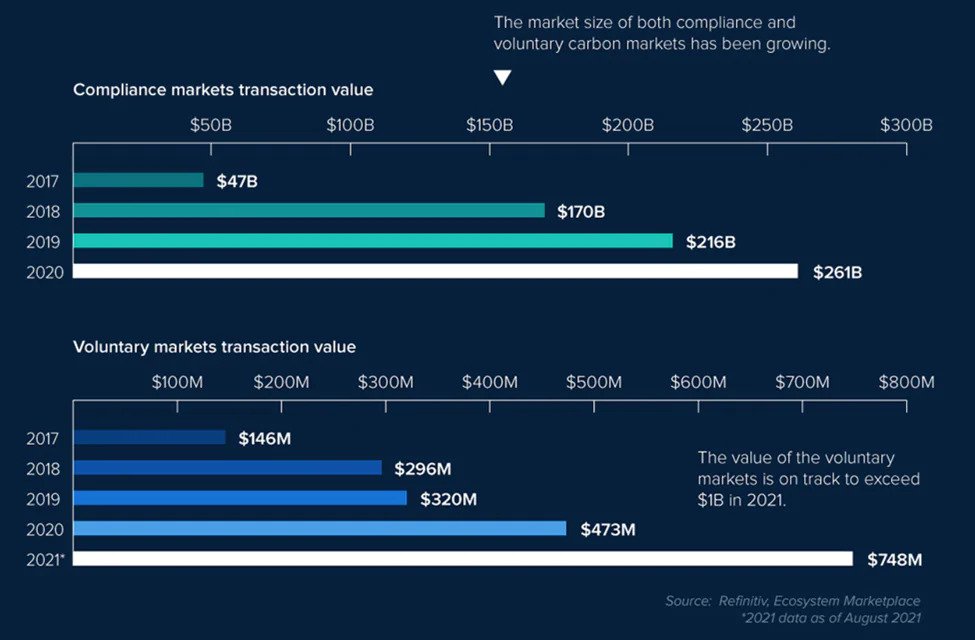
The total carbon offset market is equal to the addition of the mandatory and voluntary carbon offset markets. As far as the numerical value for the total market, that can vary because different sources calculate this value differently.
How Big Is the Mandatory Carbon Offsetting Market
Mandatory carbon offsets are used by companies or governments that by law have to account for their carbon emissions. Unlike the voluntary market, is a requirement and not a suggestion.
- In 2020, the mandatory market was valued at $261B
- This is a 46% increase in a little over a decade, as in 2008, $119B worth of credits were traded on the mandatory market
Most of that market size comes via carbon pricing – an instrument to capture the external costs of GHG emissions. And those come usually in the form of a price on the emitted CO2.
Globally, the main type of carbon pricing is achieved via Emissions Trading Systems (ETS). Those allow for trading of carbon emission units in the carbon market, effectively creating a market price on these emission units that is driven by supply and demand for these.
In 2021, these initiatives cover 11.65 GtCO2e, representing 21.5% of global GHG emissions. Globally, 65 carbon pricing initiatives have been implemented, covering 45 national and 34 subnational jurisdictions.
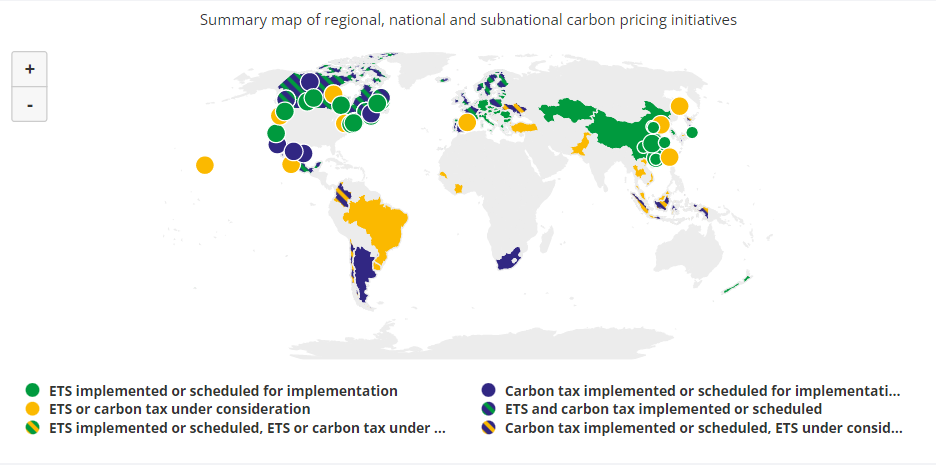
It is important to note that the vast majority of this global market size, €210B (around $240B), is still driven by Europe.
- Carbon emissions were roughly four-fold in Europe (8,450 MtCO2e in 2020) vs North America (2,010 MtCO2e)
- However, especially the higher price per unit of carbon emissions in Europe contributed to a total market size of €210B in Europe vs €26B in North America
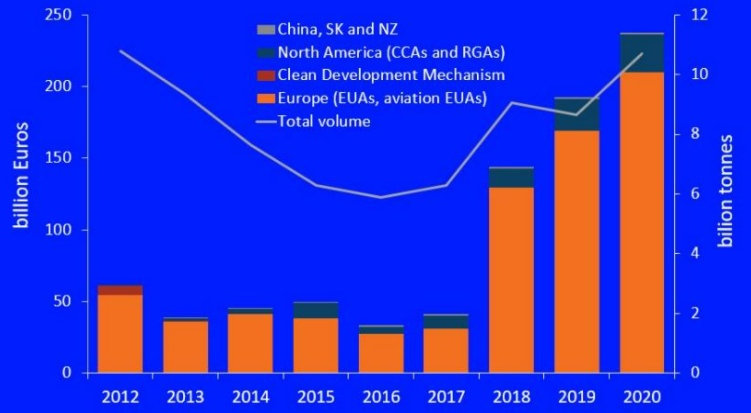
How Big Is the Voluntary Carbon Offsetting Market
Recent years have seen a strong growth trajectory for the VCM as the focus on mitigating climate change has increased.
In 2021, the VCM had posted $1.006B in sales for 298.4M credits at approximately $3.37 per credit. Going above $1 billion (B) for the first time ever and posting a 60% increase in value compared to 2020. Compare that to 2008, where only $704 million worth of credits were traded.
The energy, consumer goods, finance, and insurance sectors were the most active buyers on the market.
Nature-based and renewable energy credits on the VCM also both saw substantial growth:
- Demand for nature-based credits more than doubled in 2021 from 2020’s already record highs.
- REDD+ credits, which target the issue of deforestation, grew 280% between 2020 and 2021.
- Renewable energy credit volume rose from 42M to 80M between 2019 and 2021.
The price per VCM credit has also increased from 2019 and 2020 levels. For forestry and land-use projects, the average price per ton of CO2 has risen from $4.33 in 2019 to $4.73 in 2020 and finally $5.60 per credit in 2021. Likewise, waste-disposal and clean-burning cookstove credits have increased 42% and 16%, respectively, compared to their 2020 levels.
And just how big will the VCM get?
- The Ecosystem Marketplace predicts the VCM can grow to $50B by the year 2050
- A prediction in Bloomberg even estimates that the VCM could grow to $100 billion by 2030
The average price of a carbon offset ranges from $3-$5 per ton of CO2, but these numbers are expected to increase tenfold over the next decade as more and more countries and businesses adopt net-zero approaches to combat climate change. The demand for carbon credits is also expected to increase 15 fold by 2030.
Is the Carbon Offsetting Market Big Enough
The global carbon offset market is the platform on which carbon offsets are posted for purchase. Companies may be mandated to offset their emissions, or the everyday consumer can voluntarily contribute to them. The theoretical size of the global carbon offset market differs from the practical size of the market because of certain limitations.
| Key Points | Summary |
| We emit far more carbon than can be compensated by offsets | We emit 34 bt of CO2 annually, but of the credits for 1 bt of CO2 listed on registries, only about 300-400 mt of CO2 offsets actually get realized |
| There are not enough offsets for all of our carbon emissions | Only about 0.8-1% of the annual CO2 emissions are offset and only about 1.6-1.75% could be offset if all of the listed projects got realized |
How We Emit Far More Carbon Than Can Be Compensated by Offsets
Every year we pump more than 34 billion tons (bt) of CO2 into the atmosphere. These emissions cause climate change, air pollution, acid rain, ocean acidification, and the melting of glaciers and polar ice.
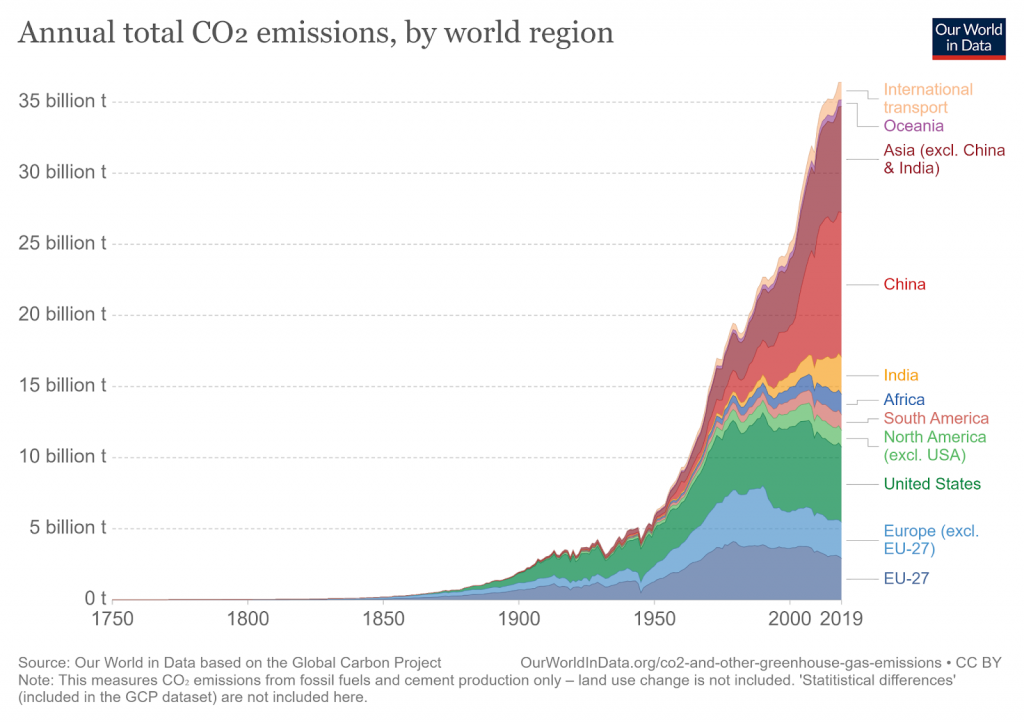
The top 5 CO2 emitting countries (amount per year) in 2020 were:
- China – 10.67 bt
- United States – 4.71 bt
- India – 2.44 bt
- Russia – 1.58 bt
- Japan – 1.03 bt
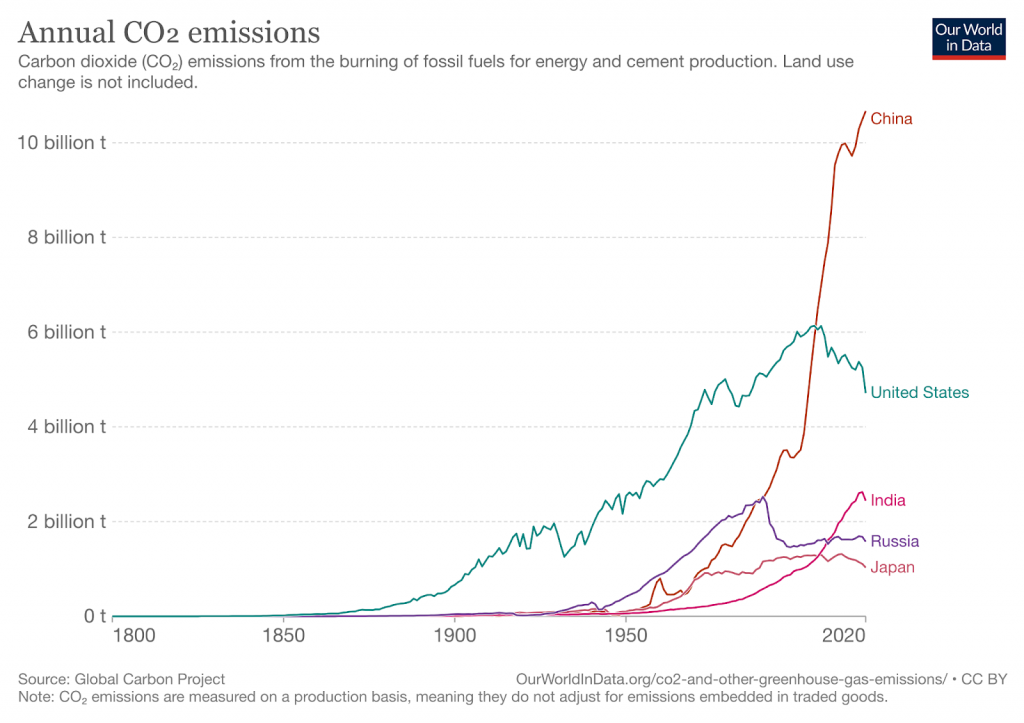
These five countries accounted for 59% of the world’s CO2 emissions in 2020, 20.43 bt out of 34.81 bt. Also, the amount of emissions from the world’s rich compared to the world’s poor is highly disproportionate. The richest 1% of the world’s population emitted more than twice as much CO2 as the poorer half of the world between 1990-2015. And the richest 10% of the world’s population, approximately 630 million (M) people, were responsible for approximately 52% of all carbon emissions during that time. rate of emissions from the richest 1% was nearly three times greater than the rate of emissions from the poorer half from 1990-2015.
Why There Are Not Enough Carbon Offsets for All Carbon Emissions
In comparison to our 34 bt of CO2 emissions, only ~1 bt of CO2 have been listed for sale on the VCM. And even then, the number of sellers on the VCM exceeds the buyers by about 600-700 mt. Meaning that only about 300-400 mt of CO2 offsets actually get realized. Meaning that only about 0.8-1% of the annual CO2 emissions are offset and only about 1.6-1.75% could be offset if all of these projects got realized.
Despite its large market value, offsetting all of our CO2 emissions is not only difficult but also impractical because there aren’t enough carbon sinks to offset every ton of CO2 produced from our collective human activities.
“Carbon Sink: an area of forest that is large enough to absorb large amounts of carbon dioxide from the earth’s atmosphere and therefore to reduce the effect of global warming”
Cambridge Dictionary
The main carbon sinks are:
- Atmosphere: The concentration of carbon in our atmosphere is currently 412 parts per million (ppm), and rising. These levels are the highest seen in the last 800,000 years. Carbon absorbs and radiates heat, which means Earth’s temperatures are rising. And with that comes rising temperature and sea levels, melting of glaciers, and ocean acidification.
- Forests: They absorb 2.6 bt of CO2 every year. The main threat to this sink is deforestation, which occurs at roughly 10 M hectares (~ 25 M acres) per year.
- Soil: They absorb approximately 25% of all carbon emissions, with most of it stored as permafrost. Not only that, but Earth’s soil contains 2,500 gigatons of carbon, more than three and four times the amount stored in our atmosphere and in all living plants/animals, respectively. One of the main threats to this sink is the melting of glacier ice due to global warming, which would instead release massive amounts of carbon into our atmosphere.
- Oceans: Phytoplankton in our oceans are responsible for absorbing approximately 25% of all carbon emissions, making them one of the world’s largest carbon sinks. But this absorbing ability has come at a cost. Increased absorption of CO2 causes ocean acidification. Over the past 200 years, our oceans have experienced a 30% increase in acidity, which harms marine life and has a ripple effect on our economy.
Once those sinks fill up, we won’t be able to offset any more carbon. Also, the more carbon we add to these sinks, the faster we degrade them and render them unusable.
Another point of concern is that we may have already exceeded Earth’s carrying capacity or the maximum number of people that the earth can sustain indefinitely. Our population is rapidly approaching 8 billion and increases by approximately 140 M people per year. The ecological footprint, the amount of environmental land needed to produce the goods that support a particular lifestyle, also continues to increase which means we are impacting the environment at levels that cannot be sustained indefinitely.
As the population and our ecological footprint grow, the need for more offsets also grows. And we already do not have enough offsets for all of our carbon emissions.
However, we must limit global warming to 1.5C by 2050 to avoid a future plagued by rising sea levels, acidified oceans, loss of biodiversity, more frequent and severe weather events, and other environmental disasters brought on by the hotter temperatures.
But because only about 0.8-1% of our annual CO2 emissions are currently offset, the VCM alone would have to increase 15 fold by 2030 and 100 fold by 2050 from 2020 levels to achieve the 1.5C by 2050 goal. But due to carbon sink limitations and the sheer amount of carbon we emit annually, this goal is not practically achievable.
Why Is the Carbon Offsetting Market Controversial
Practically, some factors prevent the global carbon offset market from reaching limitless heights. The main argument against carbon offsets is that they don’t really work, due to a variety of limitations involving their effectiveness, credibility, and success rates.
There are 9 main carbon offsetting limitations that can make the current voluntary carbon market (VCM) controversial and lead to confusion, inconsistencies, and a general distrust of the system. Below we have highlighted 5 of these limitations that limit indefinite carbon offset market growth.
Related: You can check out the full article here: “What Are the Biggest Carbon Offsetting Limitations? (All 9 Explained)”
The factors that limit indefinite carbon offset market growth include:
- You don’t reduce your own carbon footprint: When you purchase a carbon offset, you are paying someone else to cut their emissions so you don’t have to cut your own emissions.
- There are not enough offsets for all CO2 emissions: We emit far more CO2 than we can offset because of carbon sink (e.g., atmosphere, forests, soil, ocean) limitations.
- Different projects have different effectiveness rates: The varying levels of effectiveness of carbon offset programs make it difficult to choose one that actually reduces emissions. The most effective offset programs are renewable energy programs, followed by energy efficiency improvements, carbon sequestration, and aviation offset programs.
- CO2 offsets are only realized at the end of project durations: If a carbon offset program is not carried out until the end, then we cannot reap the program’s benefits. For example, planting trees is a common offset program that is only effective if those planted trees are protected during their life span for the carbon benefits to be realized.
- Not all offset projects get realized: Of the credits for 1 bt of CO2 listed on registries, only about 300-400 mt of CO2 offsets actually get realized.
Carbon offsets may be a tool in our toolbox to mitigate climate change, but the above limitations prevent them from being a cure-all. These limitations curb the market and do not allow us to simply offset all of our emissions. There are better, and more effective, ways to combat climate change that do not involve carbon offsets. .
What Are Better Alternatives to Carbon Offsetting
The COVID-19 pandemic triggered the largest decrease in energy-related carbon emissions since World War II, a decrease of 2 bt. However, emissions rebounded quickly at the end of 2020, with levels in December ending 60 mt higher than those in December 2019. This indicates that the earth is still warming at an accelerated rate, and carbon offsets are not enough to mitigate climate change.
In the media, carbon offsets are sometimes referred to as a cure for climate change. But a more effective and environmentally-friendly approach to combating climate change is to reduce your individual carbon emissions first before relying on carbon offsets. And you can reduce your carbon emissions in three main areas of your life: household, travel, and lifestyle.
To reduce your household footprint:
- Wash with cold water: Washing clothes in cold water could reduce carbon emissions by up to 11 mt. Approximately 90% of the energy is used to heat the water, so switching to cold saves also saves energy.
- Replace incandescent bulbs with fluorescent bulbs: Fluorescent bulbs use 75% less energy than incandescent ones, saving energy and thus reducing electricity demand and GHG emissions.
To reduce your travel footprint:
- Fly less: Aviation accounts for around 1.9% of global GHG emissions and 2.5% of CO2. Air crafts run on jet gasoline, which is converted to CO2 when burned.
- Walk or bike when possible: The most efficient ways of traveling are walking, bicycling, or taking the train. Using a bike instead of a car can reduce carbon emissions by 75%. These forms of transportation also provide lower levels of air pollution.
To reduce your lifestyle footprint:
- Switch to renewable energy sources: The six most common types of renewable energy are solar, wind, hydro, tidal, geothermal, and biomass energy. They are a substitute for fossil fuels (e.g., coal and oil) that can reduce the effects of global warming by limiting global GHGs and other pollutants.
- Recycle: Recycling uses less energy and deposits less waste in landfills. Less manufacturing and transportation energy costs means less GHG emissions generated. Less waste in landfills means less CH4 is generated.
- Switch from single-use to sustainable products: Reusing products avoids resource extraction, reduces energy use, reduces waste generation, and can prevent littering.
- Eat less meat and dairy: Meat and dairy account for 14.5% of global greenhouse gas emissions, with beef and lamb being the most carbon-intensive. Globally, we consume much more meat than is considered sustainable, and switching to a vegan or vegetarian diet could reduce emissions.
- Take shorter showers: Approximately 1.2 trillion gallons of water are used each year in the United States just for showering purposes, and showering takes up about 17% of residential water usage. The amount of water consumed and the energy cost of that consumption are directly related. The less water we use the less energy we use. And the less energy we use, the less of a negative impact we have on the environment.
You don’t have to make drastic changes in your lifestyle to reduce your carbon emissions. Actions that may seem small can have a big impact because those small changes add up!
Final Thoughts
Theoretically, there is no limit to the size of the global carbon offset market because there are always new carbon offset programs that can be created. But practically, there is a limit to the size of the market. Because there are not enough offsets for all CO2 emissions, different projects have different effectiveness rates, CO2 offsets are only realized at the end of project durations, and not all offset projects get realized, the market size has a limit!
Carbon offsets should not be viewed as a cure for climate change because only using them and not cutting carbon emissions from the source is not enough to reduce emissions to meet the Paris Climate Agreement target goal. Limitations involving credibility and effectiveness can be overcome by cutting your own emissions first.
Stay impactful,

Sources
- U.S. Environmental Protection Agency: Offsets and RECs -What’s the Difference?
- David Suzuki Foundation: Are carbon offsets the answer to climate-altering flights?
- Carbon Offset Guide: Mandatory & Voluntary Offset Markets
- Impactful Ninja: The History of Carbon Offsetting: The Big Picture
- The World Bank: Carbon pricing dashboard
- The World Bank: Summary map of regional, national and subnational carbon pricing initiatives
- Refinitiv: CARBON MARKET YEAR IN REVIEW 2020
- Visual Capitalist: A Complete Visual Guide to Carbon Markets
- Britannica: Carbon Offset
- ClientEarth: What is a carbon sink?
- National Oceanic and Atmospheric Administration: Climate Change – Atmospheric Carbon Dioxide
- National Wildlife Federation: Climate Change
- Food and Agricultural Organization of the United Nations: The State of the World’s Forests – 2020
- Columbia Climate School: Can Soil Help Combat Climate Change?
- World Economic Forum: The oceans are absorbing more carbon than previously thought
- National Oceanic and Atmospheric Administration: Ocean Acidification
- Australian Academy of Science: How many people can Earth actually support?
- The World Counts: How many babies are born a day?
- Global Footprint Network: Ecological Footprint
- Our World in Data: Annual total CO2 emissions
- International Energy Agency: After steep drop in early 2020, global carbon dioxide emissions have rebounded strongly
- National Wildlife Federation: Climate Change
- Yale Environment 360: Is the ‘Legacy’ Carbon Credit Market a Climate Plus or Just Hype?
- United Nations Framework Convention on Climate Change: The Paris Agreement
- Ecosystem Marketplace: Voluntary Carbon Markets Rocket in 2021, On Track to Break $1B for First Time
- Ecosystem Marketplace: Voluntary Carbon Markets Top $1 Billion in 2021 with Newly Reported Trades
- HAL archives: The emergence of voluntary carbon offsetting
- Applied Energy Services: Homepage
- Forest Carbon Partnership: What is REDD+?
- Voluntary Carbon Market: Evolution of Voluntary Carbon Market (VCM)
- Visual Capitalist: Growth of Compliance Carbon Markets vs Voluntary Carbon Markets
- Bloomberg: New $100 Billion Market Faces Disputes Over Trading Rules
- Vox: Can you really negate your carbon emissions? Carbon offsets, explained
- Food and Agricultural Organization: Carbon Markets – Which Types Exist and How They Work
- GreenBiz: Carbon offset prices set to increase tenfold by 2030
- GreenPeace: The biggest problem with carbon offsetting is that it doesn’t really work
- McKinsey Sustainability: A blueprint for scaling voluntary carbon markets to meet the climate challenge
- Impactful Ninja: What Are the Biggest Carbon Offsetting Limitations? (All 9 Explained)
- United States Agency for International Development: Scaling up energy efficiency in developing countries
- Britannica: Carbon Sequestration
- Earth.Org: How Airlines are Adopting Carbon Offsetting
- The Ocean Foundation: Reduce Your Carbon Footprint
- Cold Water Saves: Washing Laundry In Cold Water Protects A Lot More Than Just Our Clothing.
- Energy Star: Compact Fluorescent Light Bulbs (CFLs) and Mercury
- Our World in Data: Where in the world do people have the highest CO2 emissions from flying?
- Our World in Data: Which form of transport has the smallest carbon footprint?
- Stop Waste: Recycling and Climate Protection
- Impactful Ninja: Is Taking Long Showers Bad for the Environment?
- US Energy Information Administration: Renewable Energy Explained
- Global Giving: 50 Tips To Cut Down Your Carbon Footprint
- Zero Waste Europe: Reusable vs single-use packaging
- CarbonBrief: Interactive: What is the climate impact of eating meat and dairy?
- United States Environmental Protection Agency: Showerheads




